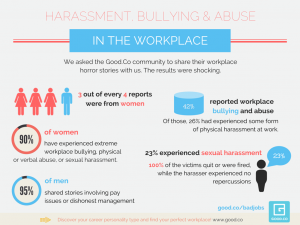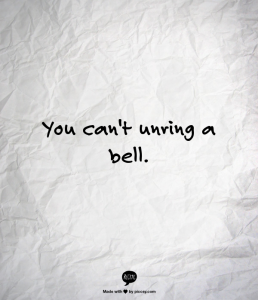We want to assume that the places where we work are a safe space. We believe this because businesses usually carry a certain level of formality, respectability, and boundaries. That’s what younger people entering the workforce should expect as a given, and yet the stats show that many women will experience some form of sexual harassment or sexual assault at work.
Relative silence in the presence of sexual harassment
When looking at the distinction between sexual harassment and sexual assault a few commonalities are clear. There shouldn’t be less of an obligation when it comes to bystanders’ culpability in creating and sustaining sexism, misogyny, and inequity for women. Any form of harassment or bullying shouldn’t be downplayed as a ‘joke’ or ‘locker room talk.’

Disgraced Hollywood producer Harvey Weinstein. Picture: Christian Alminana/Getty Images Source: Getty Images
I’m broaching this difficult subject just as I did recently when discussing the implications of domestic violence at work in a previous blog post. These issues affect us (and/or our co-workers) personally and they do not exist in a vacuum since the consequences often spill over into the places where we work.
Like many of you, I found last week’s news regarding Hollywood’s long-standing cover-up of movie mogul Harvey Weinstein deeply troubling. Yet, it also wasn’t all that surprising. As a woman with a specialization in Industrial and Organizational Psychology, and many years of experience dealing with various HR issues, I recognize that sexual harassment and other abusive behaviours in the workplace are all too common, yet the silence can be deafening.
As with other loaded topics, like politics and religion, many people in the workplace prefer to say nothing despite the undeniably tense and divisive climate that many victims of harassment/bullying, or minorities/immigrants are experiencing. I touched on this very subject in a blog article about values. In that article, I propose that rather than explicitly talking about ‘taboo’ subjects like religion and politics, frame discussions around values which may include the concepts of inclusion, tolerance, and respect. Values are also relevant within the context of willful silence when it comes to ignoring sexual harassment and/or sexual assault in professional settings.
The more things change, the more they stay the same
One of the more memorable cases that fueled widespread dialogue on workplace sexual harassment was over 25 years ago. Attorney Anita Hill became an iconic spokeswoman when she bravely came forward with a highly publicized claim against Clarence Thomas, who had been nominated to become a Judge of the United States Supreme Court. The details she shared about the gross misconduct and abuse that she experienced at work was widely challenged and would forever change her life and career (this story is captured in the 2016 film Confirmation starring Kerry Washington as Anita Hill). That historical call for action propelled, however slowly, changes in how men conducted themselves with women in the workplace, or at least that is what we had hoped for.
 Fast-forward to today and millennials may have never known the face of Anita Hill, the way my peers and I did from watching her televised court appearances so long ago. But there she was on October 17th, 2017, speaking once again on camera about the same inequality and abuse of power by men and corporations alike. Had it not been for the date-stamped recent headlines (especially this week regarding Harvey Weinstein) it would be easy to believe that it was still 1991.
Fast-forward to today and millennials may have never known the face of Anita Hill, the way my peers and I did from watching her televised court appearances so long ago. But there she was on October 17th, 2017, speaking once again on camera about the same inequality and abuse of power by men and corporations alike. Had it not been for the date-stamped recent headlines (especially this week regarding Harvey Weinstein) it would be easy to believe that it was still 1991.
Some talk, little action
And maybe in some ways, we are stuck in the 1990s. How much has been done to stop rampant abuse via intimidation and control of women in the workplace? It certainly seems that we can identify and label these violations. For instance, there is street harassment, there is domestic abuse, and then there is workplace sexual harassment. But defining the places where women become targets for sexual assault and other unwanted physical/verbal harassment seems to be where things end. Measures to eradicate these endemic problems have been slow, even when a woman is courageous enough to speak out.
Recently, there has been a promising shift in the way that people are responding to women’s claims of abuse. There’s less of the ‘he said, she said’ debate than we’ve had to endure with previous high profile sexual assault situations (e.g., Bill Cosby and CBC’S Jian Ghomeshi). In all three recent situations including Weinstein, Cosby, and Ghomeshi, rumors circulated for years about their predatory ways. Yet, these men were able to flourish in their place of work while they continued to assault and/or coerce women with impunity.
The very fact that women in 2017 must constantly and collectively chime in to ring that invisible bell of abuse just to be heard shows how much work still needs to be done. It’s time to shift from the idea of believing women, to holding companies, and HR departments accountable for failing to address these problems proactively, sensitively, and with discretion.
The bottom line and financial implications
As we have seen in the high profile cases mentioned earlier, one common theme is clear: some companies and other organizations do not want to get involved because profit and public perception are higher priorities than a victim’s truth. Since it seems to be too difficult to change the management of companies and organizations through morality or by appealing to their values it’s worth explaining the financial incentives associated with better behaviour.
What can we do differently? Stick around for part two of this blog and I will explain some financial consequences of failing to believe, intervene, and prevent workplace sexual harassment. It doesn’t just affect the victim — it can affect organizations financially too. I will also discuss what can be done to inspire a healthier, safer and financially viable work environment without focussing on what the potential victim can do to prevent sexual harassment (or other forms of mistreatment).
Need help dealing with delicate or high-stakes career or HR issue? I invite you to contact me privately. I offer a free 15 to 20-minute initial consultation by phone. Or, if you prefer, you can contact me by email, or via direct message on Twitter, Facebook, or LinkedIn.
More than career coaching, it’s career psychology®.
I/O Advisory Services – Building Resilient Careers and Organizations.
Easily share this article using any of the social media icons below!





